Journal of Service Science and Management
Vol.5 No.1(2012), Article ID:18229,8 pages DOI:10.4236/jssm.2012.51007
Study on Supply Chain Cooperative Games between Airport and Cargo Airways within International Air-Transport Hub
![]()
Institute of Airport Economics, Civil Aviation University of China, Tianjin, China.
Email: violetsdy@live.cn
Received November 19th, 2011; revised December 28th, 2011; accepted January 13th, 2012
Keywords: International Air-Transport Hub; Airport and Cargo Airways; Supply Chain; Cooperative Games
ABSTRACT
Speed economy, proposed by Japanese scholars Masaki Tamura, refers to get the cost savings flow by accelerating the transaction process [1], which brings the a large market space to the cargo/express delivery industry [2]. Due to the rapidly growth of China air cargo/express market and the ongoing increasingly opening up of the sky, international cargo/express giants have set up their hubs in China. The arrival of these global logistics integrators has brought a lot of influence to the development of airport. Hereinto, the unbalance between the scales of China cargo hubs and the rapid demand of air cargo/express development, the cooperation model of airports and air cargo/express have become the most urgently issue to explore. Therefore, on the basis of airport and airway co-competition analysis, the characteristics of the air cargo supply chain, and the airports and cargo airlines supply chain behavior, this paper will use the non-cooperative game of principal-agent model and the cooperative game model to analysis the revenue distribution of airport and cargo airway on the supply chain, this paper applies the cooperative game theory within a supply chain to analyze the cooperation model of airports and air cargo/express, so as to makes strategy suggestions on airport development.
1. Introduction
Since 1978, the freight business has changed tremendously. One man, Fred Smith, believed that mixing passengers’ traffic with freight traffic was not the future because he believed route patterns for passengers and cargo were different [3]. So he created FedEx in 1973 and started earning profits by his third year, and also a new model, “Hub & Spoke System”, so as to full fill his idea of providing overnight service. This is the origin of hub in air transportation.
Although there are four types of hubs, which is LandUse, Shipping, Air-Transport and Integrated, this paper will focus on the Air-Transport Hub, especially the international one, which transfer mode is “Trunk & Trunk” [4] of a hub, i.e. the Express Hub, according to the in accordance with the categories of goods. Sum up, the International Air-Transport Hub specifically refers to the international air cargo/express hub.
Hub airport of cargo, i.e. Cargo Hub, with the characteristic of high proportion of transit operations, ability to efficiently interface flights [5], is the major hub airport for air cargo services in an area. A cargo hub which is centrally located allows carriers to minimize fuel burn and transit time between the hub and various spokes. The latter is particularly important as package customers have come to expect not just overnight service, but late dropoff and early morning delivery. Such as Memphis and Louisville, both located slightly eastward of the nation’s center. This positioning allows for reduced delivery time to the east coast for morning deliveries. The first planes take off at 2 am central time heading to Europe or the east coast, helping to compensate for the time zone change [3].
According to the territory situation of China mainland; there are several acknowledged hub airport of cargo. They are Beijing Capital International Airport or Tianjin Binhai International Airport in North China, Shanghai Pudong International Airport in the East, Guangzhou Baiyun International Airport or Shenzhen Baoan International Airport in the South, Wuhan Tianhe Airport in the Central, Chengdu Shuangliu International Airport or Kunming Xiaoshao International Airport in Southwest, and Xi’an Xianyang Airport or Urumqi Diwobao International Airport in Northwest.
Due to the rapidly growth of China air express market and the ongoing increasingly opening up of the sky, international express giants have set up their hubs in China, such as FedEx’s Asia-Pacific hub in Guangzhou Baiyun International Airport, UPS’ international air transport hub and DHL’s North Asia hub in Shanghai Pudong International Airport. The arrival of these global logistics integrators has brought a lot of influence to the development of airport, such as, increasing the airport traffic, improving the utilization of airport facilities and equipment, enhancing the status of hub, and etc. meanwhile, putting forward much higher requirements on the airport facilities, equipment and management.
Hereinto, the unbalance between the scales of China’s cargo hubs and the rapid demand of air express development, the cooperation model of airports and air express have become the most urgently issue to explore. Therefore, this paper applies the cooperative game theory within a supply chain to analyze the cooperation model of airports and air express, so as to makes strategy suggestions on airport development.
2. Methodology
Reviewed from the latest literatures, the studies center on International Air-Transport Hub are mostly about the site factors, however, there are no research on the relationship between hub airports and the cargo airways. Also the study of the relationship between airports and airlines are limited. The findings of their papers are a summary of the phenomenon, the game relationship between the airport and airway. But there is still no use of game theory on these relationship studies.
Therefore, on the basis of airport and airway co-competition analysis, the characteristics of the air cargo supply chain, and the airports and cargo airlines supply chain behavior, this paper will use the non-cooperative game of principal-agent model and the cooperative game model to analysis the revenue distribution of airport and cargo airway on the supply chain, so as to makes strategy suggestions on airport development, from a strategic macrolevel, management meso-level and operational microlevel, as in Figure 1.
3. Results
The profits of airport and cargo airways are closely related to each other, while the two sides are also profitable contender. Cooperation or competition, if cooperation, how to gain equitable distribution of benefits. By establishing non-cooperation of the principal-agent game model and cooperative game model, it can be concluded: cooperation can bring more total revenue, which using the improved  solution can find equilibrium. Under this mechanism, the cooperation will be more stable.
solution can find equilibrium. Under this mechanism, the cooperation will be more stable.
3.1. Co-Competition Relationship between Airport & Airway
Both as the supplier of air transport services, airport and airway firstly are strategic partner. Secondly, the airport’s aviation business incomes are all come from the airway, so they are customer and supplier. At the same time, there is a certain degree of competition between them in the utilization of resources and facilities control [6].

Figure 1. The logic and methodology.
Being in an alternative circumstance, air transport customers may prefer a particular airport due to a certain airway, or only loyal to one airway so as to use an airport, also may be both [7]. Safety, service, and efficiency are same goal of both airport authorities and airways, which is the basis of the cooperation of airport and airway [8].
3.2. The Air Cargo Supply Chain Analysis
In general, the mature structure of supply chain contains a large number of SMEs, and some core large companies, which formed the “dual structure” supply chain [9]. Air cargo supply chain can be divided into several different independent stages as in Figure 2, and each stage can be subdivided into many independent processes. In this case, air cargo transport industry is not only formed by a large number of vertically integrated companies, but also many SMEs specialize in a certain stage (such as sales, airport ground handling, etc.). The air cargo supply chain, mainly formed by the cargo airways (core of the supply chain), and its supply chain partners (SMEs), including air forwarders, airport ground handling agents, ground delivery companies, and some other outsourcing companies (such as aviation insurance companies, etc.), as in Table 1.
3.3. Supply Chain Behavior Characteristics of Airport & Cargo Airway
Cargo airway is core enterprise in the supply chain. In the overall process of air freight, which products flow from consign to loading, unloading, until the final distribution, it is a process that cargo airway essentially outsource non-core businesses to others. The outsourcings of these businesses are completed by other companies in the supply chain. By outsourcing non-core business, cargo airway may achieve costs reduce, operational risks, make up their own shortcomings, rapid response to market, enhance their core competitiveness, and even some other targets.
Although cargo terminals in airport do not own aircrafts, they control the handling and loading agent of airways for monopoly on airport resources, can charge high fees of cargo handling services. Currently, many airports also have freight forwarding business, with its advantage of loading agent of many airways, carry out fierce competition with freight forwarders.
3.4. Cooperation Strategic Choices Based on Behavior Characteristics
Airport and Cargo airway are different aspect in same supply chain, with different behavioral characteristics in the transaction process, can be divided into two types: reciprocity enterprise and opportunistic enterprise [10]. Due to the asymmetry of information, each enterprise only
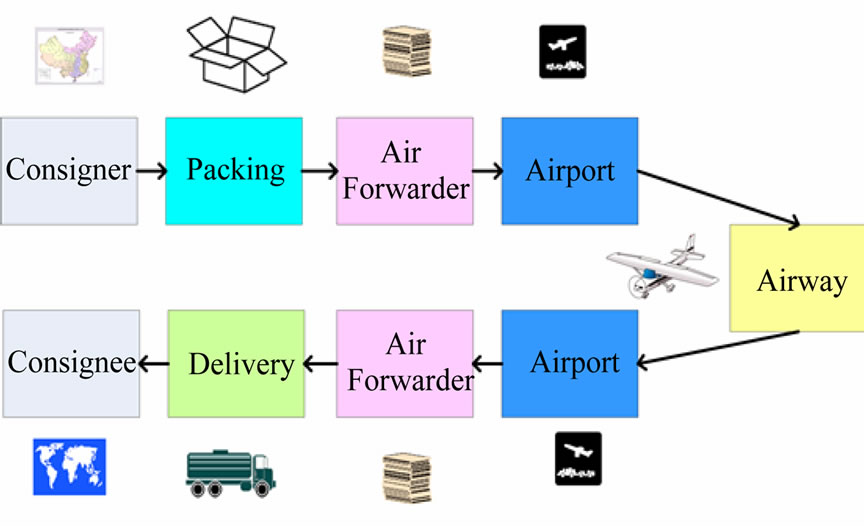
Figure 2. The air cargo supply chain.
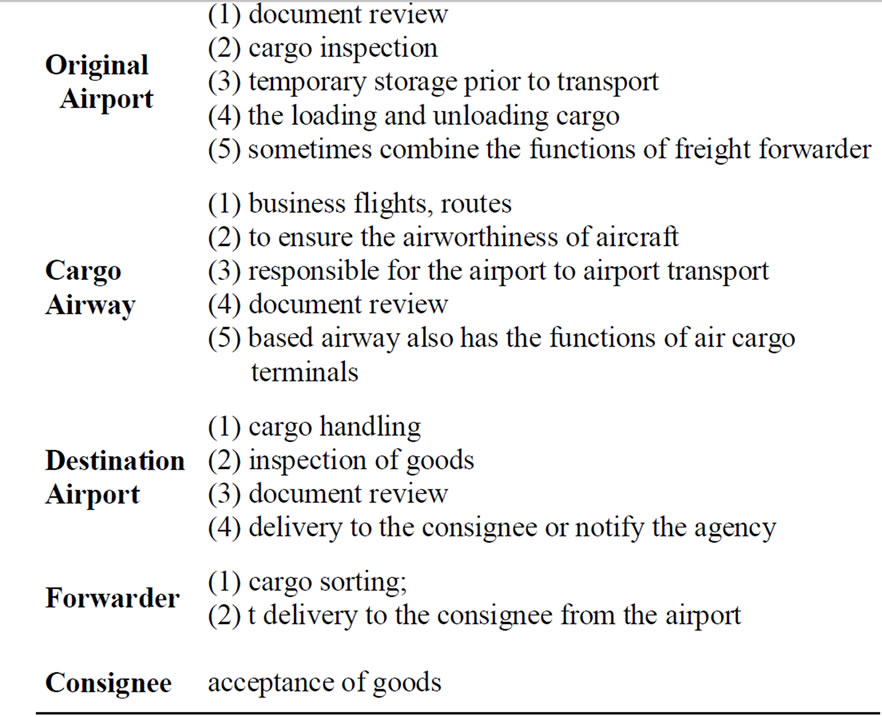

Table 1. Responsibility of main sectors in the air cargo supply chain.
knows his own type, while do not know the others in the game. So the strategy space of the two types is {Cooperation (C), Breach-rust (B)}. The behavioral characteristics of each enterprise’s strategy as in Table 2.
As in Table 2, coordination refers to that the two solve

Table 2. Behavioral characteristics and strategy space of the two types.
the problems together after negotiations, such as joint design on air freight process, joint investment on production and services develop, set the price together with contract etc. Information sharing refers to the sharing of flight loading, airport handling and ramp loading and some other key data.
If the opportunistic enterprise adopts a coordination strategy, the performance will be the same as reciprocity enterprise {Coordination, Information sharing}. If the opportunistic enterprise adopts a breach-trust strategy, it will block their own information and effort to obtain others’ information, so as to obtain short-term interests by while the other information provided by malicious high (low) price and etc. before turning to a new partner. If the reciprocity enterprise choose to breach trust, it will remain a tendency to mutual benefit (publish information), but to adopt non-coordination strategy when aware of others non-coordination [11].
On the one hand, as the operation of International AirTransport Hub related to the interests of both the airport and cargo airway, they will take a cooperative strategy, i.e. Cooperation (C). On the other hand, in the operation of International Air-Transport Hub, the airport and cargo airway with a symbiotic nature, so information sharing is an important contribution to them. Thus, the probability of “non-information sharing” is minimal; both of them are majorly a reciprocity enterprise. Therefore, the game between airport and cargo airway is approximately the same to the game of two reciprocity enterprise.
The significance of each variable in the model:
E: Successful coordination (both coordination) lead to excess utility to the enterprise;
C: Enterprise’s input of coordination;
P: Positive utility bring by other enterprise’s information sharing;
N: Negative effect bring by enterprise’s unilaterally release information;
0: The utility of non-Coordination and non-information sharing during the transaction process;
α: The probability of cooperation strategy selection;
So after introducing uncertainty, the strategy space and payoff matrix of airport, reciprocity enterprise (A), and cargo airway, reciprocity enterprise (B), in the game as in Table 3.
For both parties of the game, it has the same utility by

Table 3. Strategy space and payoff matrix of the game between two reciprocity enterprise.
selecting cooperation strategy or breach-trust strategy, within a mixed strategy.
 (1)
(1)
 (2)
(2)
 : The expectation function of airport and cargo airway, so
: The expectation function of airport and cargo airway, so
 (3)
(3)
With (3) into (2), it can be draw:
 (4)
(4)
During the operating of International Air-Transport Hub, if the probability of choosing cooperative strategies by airport is greater than , the optimal strategy for cargo airway is to choose cooperation strategy, otherwise to choose breach-trust strategy.
, the optimal strategy for cargo airway is to choose cooperation strategy, otherwise to choose breach-trust strategy.
Although the balance of the supply chain is dynamic, the strength, chips and status of the enterprise in the supply chain is changing following the change of supply and demand [12], however, during the current development of airport in China, airport and airway have chosen a win-win cooperation strategy, the control of airport is still obviously weak.
3.5. Profit Distribution Game of Airport & Cargo Airway
Airport is the downstream of cargo airway in the supply chain, to provide services for cargo airway. Based on this, this paper attempts to discuss the bargaining between the airport and cargo airway on a product (such as packing services) within a supply chain. Set  as the sales price of the product, and
as the sales price of the product, and  is the market demand. For the supply chain assumptions as following:
is the market demand. For the supply chain assumptions as following:
1) There is a cargo airway and an airport in the supply chain;
2) The unit cost of production for cargo airway is constant , the airport services cost per unit of product is also constant
, the airport services cost per unit of product is also constant , and note
, and note ;
;
3) The product demand is the negative exponential function of price , which
, which  are constant and
are constant and , as the services products are non-necessities product, full of price elasticity, so
, as the services products are non-necessities product, full of price elasticity, so .
.
3.5.1. Non-Cooperative Game of Principal-Agent Model
Considering the ground handling and other services, which airport supplied as a product for cargo airway, cargo airway and the airport can be regarded as the principalagent relationship. By developing incentives, principal try to promote the agent working actively. It is assumed that cargo airway give the volume of services and pricing decision-making authority to the airport, and maximum the benefits by developing incentives.
The incentive mechanism is controlled by the excitation function ,
,  is a function of p, q, d, is the excitation parameters. It is assumed that the incentive is linear.
is a function of p, q, d, is the excitation parameters. It is assumed that the incentive is linear.
 (5)
(5)
The return of airport is a linear combination of sale profits and revenue. The return of airport  is determined by excitation function, i.e.
is determined by excitation function, i.e. . When the excitation function is fixed, the principal, cargo airway, adjust the excitation parameters
. When the excitation function is fixed, the principal, cargo airway, adjust the excitation parameters  to adjust the return of airport, so as to make greatest profits. The profits function of cargo airway is
to adjust the return of airport, so as to make greatest profits. The profits function of cargo airway is .
.
Obviously, this is a dynamic two-stage game with complete information. The first stage (cargo airways’ equilibrium), the principal fixes the incentive parameters to maximize their own income; the second stage (airport’s equilibrium), the agent makes the greatest profits with price . The total revenue of the two party on the supply chain is
. The total revenue of the two party on the supply chain is , and
, and .
.
Use the backward induction to solve:
1) Airport predicted the cargo airway’s incentive parameter is , and the pricing strategy of the revenue function is
, and the pricing strategy of the revenue function is :
:
 (6)
(6)
with  into (6):
into (6):
 (7)
(7)
Based on the first-order conditions of unconstrained optimization, set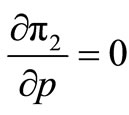 , simplify the optimal strategy for the airport:
, simplify the optimal strategy for the airport:
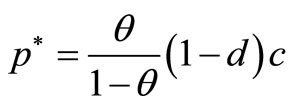 (8)
(8)
2) The cargo airway fixes the incentive parameters  to maximize their own income, the income function of the cargo airway is:
to maximize their own income, the income function of the cargo airway is:
 (9)
(9)
When the strategy of airport is , there is:
, there is:
 (10)
(10)
Based on the first-order conditions of revenue optimization, set , simplify the optimal strategy for the cargo airway:
, simplify the optimal strategy for the cargo airway:
 (11)
(11)
3) By using the backward induction, the optimal strategy of airport can be calculated:
 (12)
(12)
So  is the only refining Nash equilibrium solution of the two-stage game.
is the only refining Nash equilibrium solution of the two-stage game.
The revenue of the cargo airway and airport, under the Nash equilibrium, are:
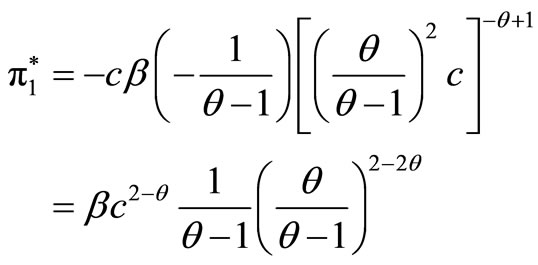 (13)
(13)
 (14)
(14)
3.5.2. Cooperative Game Model and Profit Distribution
While cooperation, based on information-sharing the cargo airway and airport will consider maximizing total return of both sides. Total revenue of Cooperation is greater than the sum of earnings in non-cooperation, which means the opportunity cost of cooperation is a prerequisite to achieve cooperation.
In cooperation, whether the increased income is fairly distributed will be the key of a smoothly and stability cooperation. They first introduced the issue of cooperative games and bargaining equilibrium solution. By introduce the equilibrium solution of cooperative games and bargaining issue, as following:
1) The overall gain in cooperation.
The two sides formed a cooperative alliance, through the price means to achieve their maximum benefits. According to the model assumptions, the alliance’s revenue function is:
 ,
, (15)
(15)
The first-order condition of both sides’ benefits maximizing:
 (16)
(16)
The unique solution meets the conditions , is:
, is:
 (17)
(17)
At this point, the total income of the alliance is:
 (18)
(18)
Theorem: overall benefits of cooperative alliance are greater than the sum of earnings in non-cooperation.
Proof: the overall benefits function of cooperative alliance  is a strictly convex function of price
is a strictly convex function of price , under the domain
, under the domain  [13].
[13].
 is the maxima of the function. So
is the maxima of the function. So  is also the only maximum of f in the whole domain.
is also the only maximum of f in the whole domain.
Therefore, to the equilibrium price of the principal-agent model , there must be
, there must be .
.
Proof Completed.
According to the theorem, the cooperation will lead a greater overall income, and thus cooperation is feasible. Moreover, when the two parties full cooperation will also lead transaction costs reduced, smoothly information flows and so on, which will make the alliance overall revenue increase, so the cooperation is the optimal choice of both parties. However, whether these additional benefits can be reasonably allocated will be the bottlenecks of a smoothly and stability cooperation.
2) The equilibrium solution of income distribution in of cargo airway and airport alliance.
The revenue allocation of cargo airway and airport in the supply chain will be discussed as following:
In 1950s, the founders of game theory, John Nash gave a formal description on bargaining theory and proposed a two-person Nash bargaining solution [14]. In 1970s, two game theory scholars E. Kalai and M. Smorodi proposed an alternative solution, called the bargaining problem  solution [15].
solution [15].
In alliance S, participants ,
,  is the contribution which participant i to the S, based on contribution of the participants [16] gives a n participants cooperative game equilibrium solution-Shapley value. So far, this method is still recognized by most scholars and widely used. The equilibrium solution is
is the contribution which participant i to the S, based on contribution of the participants [16] gives a n participants cooperative game equilibrium solution-Shapley value. So far, this method is still recognized by most scholars and widely used. The equilibrium solution is , named improved
, named improved  equilibrium solution.
equilibrium solution.
In the principal-agent game, revenue of cargo airway and airport under the Nash equilibrium is (13), (14). And the total income of the alliance is (18).
According to the improved  equilibrium solution, there are 2 participants, each contribution is
equilibrium solution, there are 2 participants, each contribution is ,
,
 and the proportion factor is
and the proportion factor is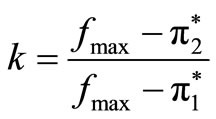 .
.
The equilibrium solution of this bargaining problem is:
 (19)
(19)
Obviously, relative to the non-cooperative game of principal-agent model, two participants revenue have increased and the increased revenue is measured by its contribution to the alliance, which will be accepted by both sides, and will conducive to a long-term stable relations of cooperation.
The product market equilibrium price of cooperation  is lower than the equilibrium price in principalagent model
is lower than the equilibrium price in principalagent model . This shows that the cargo airways and the airport’s full cooperation will increase the mutual benefits to the consigner (consumer), which will increase the market competitiveness of the product. This is the common goal of both cargo airway and airport in nowadays demand-pull market competition. Thus, cooperation is a “win-win” solution.
. This shows that the cargo airways and the airport’s full cooperation will increase the mutual benefits to the consigner (consumer), which will increase the market competitiveness of the product. This is the common goal of both cargo airway and airport in nowadays demand-pull market competition. Thus, cooperation is a “win-win” solution.
4. Conclusions
1) The air cargo service chain has the characteristics of supply chain. Cargo airway and airport are the upstream and downstream businesses of one supply chain, while airport provides flight support services and ground handling services for cargo airway. According to the behavioral characteristics of the supply chain, enterprises can be divided into two types: reciprocity enterprise and opportunistic enterprise. Due to symbiotic nature of airport and cargo airway, due to the symbiotic nature of the two operations, they are both reciprocity enterprise, likely to share information even under breach trust strategy.
2) Based on the characteristics of reciprocity enterprises, the airport and airway can not only choose the principal-agent relationship within the non-cooperative game strategy, but also the cooperative game strategies. Game analyses shows that benefits both increased with cooperation, and also bring returns to the consigner.
3) During the current development of airport in China, airport and airway have chosen a win-win cooperation strategy, a principal-agent model. With the IT and management level increasing of airport, the market control of airport will become stronger, and also the status in the cooperative game. Then the cooperation of airport and airway will shift to a new alliance mode, a more stable one. That is, if the airport and airway cannot form the alliance, the airway will be transferred to other airport to operate where there is a lower cost of agent service.
4) So as to establish a more stable cooperative alliance mode, strategy suggestions on airport development should be carrying out in strategic macro-level, management meso-level and operational micro-level.
Strategic aspect (macro-level):
• To co-ordinate the development strategy and planning of International Air-Transport Hub and the airport.
• To enhance the continued support capacity of airport.
• To diversified the financing channels of airport and socialized the service support in order to reduce negative impact of International Air-Transport Hub.
• To strengthen policy and regulations, so as to create opportunities for airport to be an International AirTransport Hub.
Management aspect (meso-level):
• To establish “International Air-Transport Hub Plan” so as to track the needs of international air cargo demand.
• To take full advantage of International Air-Transport Hub operation opportunity, to enhance the market control of airport.
• Effectively change the airport’s operating mechanism, to improve the management level of cargo airport.
• To improve the international service standards of airport so as to strengthen cooperation.
Operational aspect (micro-level):
• To seeking strategic partners actively, to provide efficient service.
• To establish air logistics information systems, to achieve the logistics information sharing.
• To construct air logistics park, to enhance the airport cargo capacity.
• To establish convergence hub of railways, ports, highways and other transport mode.
5) This article the first time applies of the theory of supply chain collaboration to analysis the relationship between the airport and cargo airway, and discusses the stability of cooperation in the view of benefits distribution, and also develop strategy suggestions in strategic macro-level, management meso-level and operational micro-level for the airport. However, the game model needs to be further improved. For example, due to the airports and cargo airways’ statistics shortage status in China and the limitations of existing research data, this article only analyzes the bargaining of one single product, not involving a variety of products, but in reality the product is often more than one.
5. Acknowledgements
This project is sponsored by the Fundamental Research Funds for the Central University, B Class (No.2010B- 001).
REFERENCES
- D. H. Wei, “On Economic of Enterprise Organization,” South China Economy, No. 5, 1997, pp. 46-48.
- Chinese Academy of International Trade and Economic Cooperation, “Report on China Express Market,” Review of Economic Research, No. 34, 2006, pp. 2-24.
- A. Cosmas and B. Martini, “UPS and FedEx Air Hubs: Comparing Louisville and Memphis Cargo Hub Operations,” Cosmas and Martini 16.781 Term Project December 14th, 2007.
- M. G. Sun and C. Y. Song. “Consumption Logistics Management,” China Social Sciences Publishing Press, Beijing, 2005, pp. 108-109.
- Y. Chen and X. Y. Gao, “Study on Air Hub Construction in China,” Aviation Management, No. 2, 2002, pp. 45-51.
- J. S. Zhang and M. Xie, “Research on Strategic Relationship and its Connotation of Airport and Airline,” China Civil Aviation, No. 9, 2008, pp. 36-40.
- R. L. Huang, “Study on Strategy Alliance of Baiyun Airport,” Jinan University, Guangzhou, 2002.
- D. M. Wang, “Discuss on Operational Relationship of Airport and Airline,” Aviation Management, No. 3, 2004, pp. 37-39.
- Y. Z. Hou, “Alliance Prcing and Profit Distribution Tactics under the Closed-loop Supply Chain,” Logistics Technology, No. 6, 2004, pp. 50-52.
- V. Anderhub, “An Experimental Study of the Repeated Trust Game with Incomplete Information,” Journal of Economic Behavior & Organization, Vol. 48, No. 2, 2005, pp. 197-216. doi:10.1016/S0167-2681(01)00216-5
- H. Yang, “Evolutionary Game Analysis of Opportunists and Reciprocitarians of the Supply Chain,” Operations Research and Management Science, No. 14, 2005, pp. 55- 58.
- C. Zong, “Research on Cooperation of Supply Chain Enterprises Based on Game Theory,” Tianjin Normal University, Tianjin, 2006.
- H. D. Zheng, “Mathematical Programming,” Shandong Education Press, Jinan, 1997, pp. 169-174.
- J. Nash, “Two person Cooperative Games,” Econometrics, Vol. 21, No. 1, 1953, pp. 125-140. doi:10.1016/S0167-2681(01)00216-5
- E. Kalai and M. Smorodinsky, “Other Solutions to Nash’s Problem,” Econometrica, Vol. 43, No. 3, 1975, pp. 513- 518. doi:10.2307/1914280
- L. S. Shapley, “Avalue for n-Person Games,” Kuhn and Theker, Eds., Contributions to the Theory of Games, Volume 2 of Annals of Mathematics Studies, Princeton University Press, Princeton, 1953, pp. 307-317.

